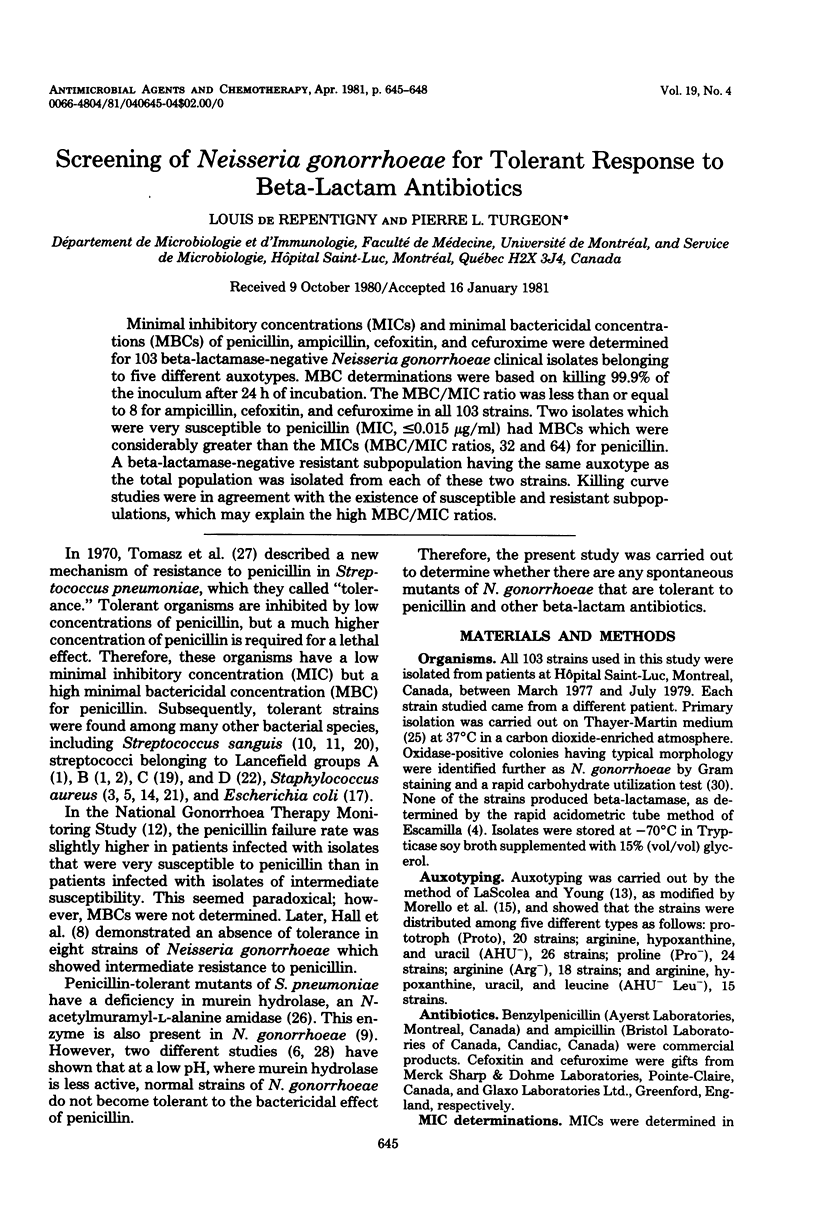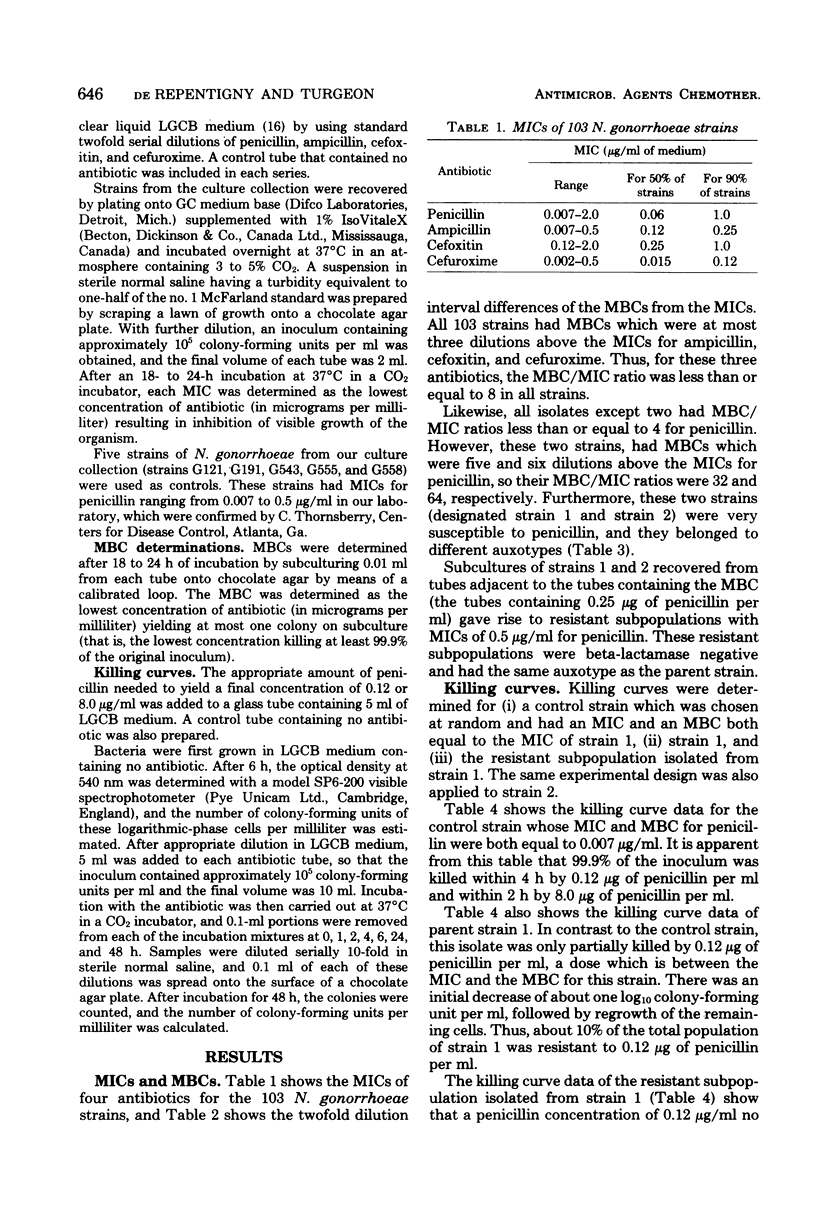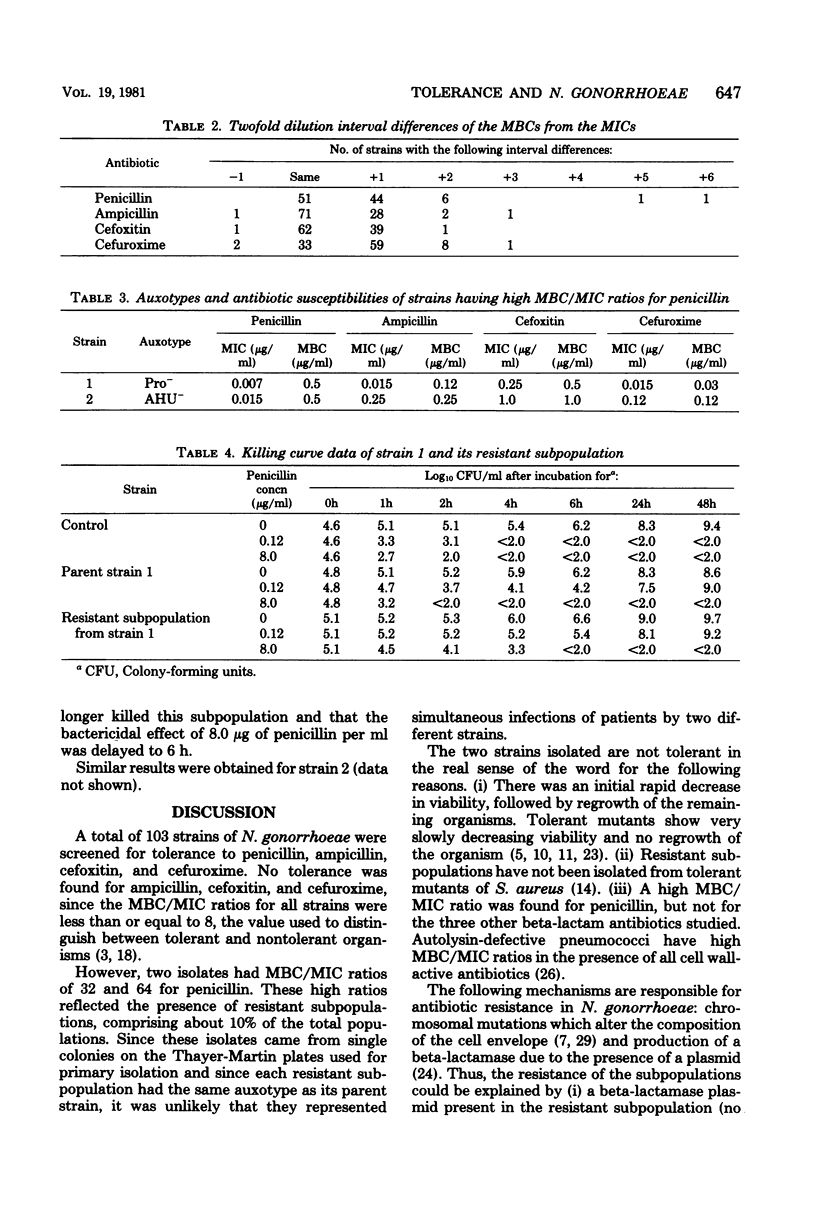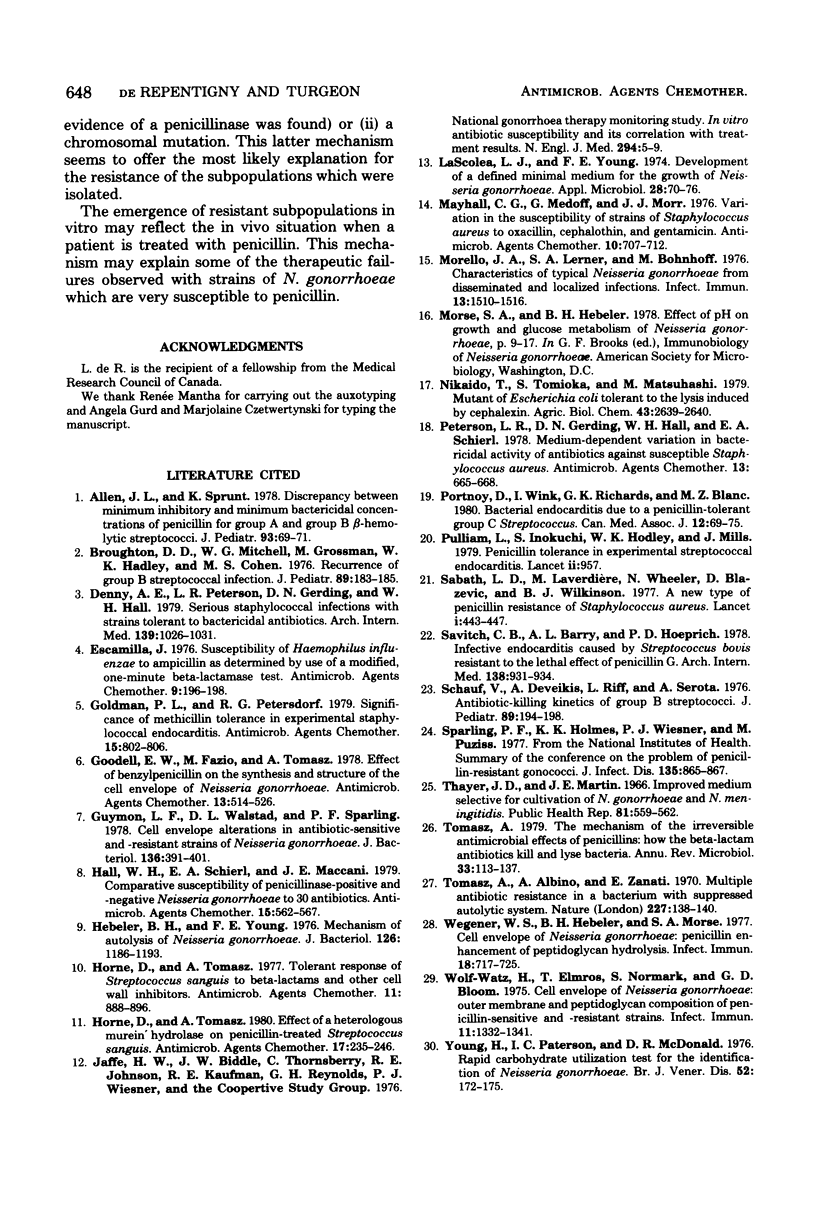Abstract
Minimal inhibitory concentrations (MICs) and minimal bactericidal concentrations (MBCs) of penicillin, ampicillin, cefoxitin, and cefuroxime were determined for 103 beta-lactamase-negative Neisseria gonorrhoeae clinical isolates belonging to five different auxotypes. MBC determinations were base on killing 99.9% of the inoculum after 24 h of incubation. The MBC/MIC ratio was less than or equal to 8 for ampicillin, cefoxitin, and cefuroxime in all 103 strains. Two isolates which were very susceptible to penicillin (MIC, less than or equal to 0.015 micrograms/ml) had MBCs which were considerably greater than the MICs (MBC/MIC ratios, 32 and 64) for penicillin. A beta-lactamase-negative resistant subpopulation having the same auxotype as the total population was isolated from each of these two strains. Killing curve studies were in agreement with the existence of susceptible and resistant subpopulations, which may explain the high MBC/MIC ratios.
Full text
PDF



Selected References
These references are in PubMed. This may not be the complete list of references from this article.
- Allen J. L., Sprunt K. Discrepancy between minimum inhibitory and minimum bactericidal concentrations of penicillin for group A and group B beta-hemolytic streptococci. J Pediatr. 1978 Jul;93(1):69–71. doi: 10.1016/s0022-3476(78)80603-9. [DOI] [PubMed] [Google Scholar]
- Broughton D. D., Mitchell W. G., Grossman M., Hadley W. K., Cohen M. S. Recurrence of group B streptococcal infection. J Pediatr. 1976 Aug;89(2):182–185. doi: 10.1016/s0022-3476(76)80441-6. [DOI] [PubMed] [Google Scholar]
- Denny A. E., Peterson L. R., Gerding D. N., Hall W. H. Serious staphylococcal infections with strains tolerant to bactericidal antibiotics. Arch Intern Med. 1979 Sep;139(9):1026–1031. [PubMed] [Google Scholar]
- Escamilla J. Susceptibility of Haemophilus influenza to ampicillin as determined by use of a modified, one-minute beta-lactamase test. Antimicrob Agents Chemother. 1976 Jan;9(1):196–198. doi: 10.1128/aac.9.1.196. [DOI] [PMC free article] [PubMed] [Google Scholar]
- Goldman P. L., Petersdorf R. G. Significance of methicillin tolerance in experimental staphylococcal endocarditis. Antimicrob Agents Chemother. 1979 Jun;15(6):802–806. doi: 10.1128/aac.15.6.802. [DOI] [PMC free article] [PubMed] [Google Scholar]
- Goodell E. W., Fazio M., Tomasz A. Effect of benzylpenicillin on the synthesis and structure of the cell envelope of Neisseria gonorrhoeae. Antimicrob Agents Chemother. 1978 Mar;13(3):514–526. doi: 10.1128/aac.13.3.514. [DOI] [PMC free article] [PubMed] [Google Scholar]
- Guymon L. F., Walstad D. L., Sparling P. F. Cell envelope alterations in antibiotic-sensitive and-resistant strains of Neisseria gonorrhoeae. J Bacteriol. 1978 Oct;136(1):391–401. doi: 10.1128/jb.136.1.391-401.1978. [DOI] [PMC free article] [PubMed] [Google Scholar]
- Hall W. H., Schierl E. A., Maccani J. E. Comparative susceptibility of penicillinase-positive and -negative Neisseria gonorrhoeae to 30 antibiotics. Antimicrob Agents Chemother. 1979 Apr;15(4):562–567. doi: 10.1128/aac.15.4.562. [DOI] [PMC free article] [PubMed] [Google Scholar]
- Hebeler B. H., Young F. E. Mechanism of autolysis of Neisseria gonorrhoeae. J Bacteriol. 1976 Jun;126(3):1186–1193. doi: 10.1128/jb.126.3.1186-1193.1976. [DOI] [PMC free article] [PubMed] [Google Scholar]
- Horne D., Tomasz A. Lethal effect of a heterologous murein hydrolase on penicillin-treated Streptococcus sanguis. Antimicrob Agents Chemother. 1980 Feb;17(2):235–246. doi: 10.1128/aac.17.2.235. [DOI] [PMC free article] [PubMed] [Google Scholar]
- Horne D., Tomasz A. Tolerant response of Streptococcus sanguis to beta-lactams and other cell wall inhibitors. Antimicrob Agents Chemother. 1977 May;11(5):888–896. doi: 10.1128/aac.11.5.888. [DOI] [PMC free article] [PubMed] [Google Scholar]
- La Scolea L. J., Jr, Young F. E. Development of a defined minimal medium for the growth of Neisseria gonorrhoeae. Appl Microbiol. 1974 Jul;28(1):70–76. doi: 10.1128/am.28.1.70-76.1974. [DOI] [PMC free article] [PubMed] [Google Scholar]
- Mayhall C. G., Medoff G., Marr J. J. Variation in the susceptibility of strains of Staphylococcus aureus to oxacillin, cephalothin, and gentamicin. Antimicrob Agents Chemother. 1976 Oct;10(4):707–712. doi: 10.1128/aac.10.4.707. [DOI] [PMC free article] [PubMed] [Google Scholar]
- Morello J. A., Lerner S. A., Bohnhoff M. Characteristics of atypical Neisseria gonorrhoeae from disseminated and localized infections. Infect Immun. 1976 May;13(5):1510–1516. doi: 10.1128/iai.13.5.1510-1516.1976. [DOI] [PMC free article] [PubMed] [Google Scholar]
- Peterson L. R., Gerding D. N., Hall W. H., Schierl E. A. Medium-dependent variation in bactericidal activity of antibiotics against susceptible Staphylococcus aureus. Antimicrob Agents Chemother. 1978 Apr;13(4):665–668. doi: 10.1128/aac.13.4.665. [DOI] [PMC free article] [PubMed] [Google Scholar]
- Portnoy D., Wink I., Richards G. K., Blanc M. Z. Bacterial endocarditis due to a penicillin-tolerant group C streptococcus. Can Med Assoc J. 1980 Jan 12;122(1):69-70, 75. [PMC free article] [PubMed] [Google Scholar]
- Pulliam L., Inokuchi S., Hadley W. K., Mills J. Penicillin tolerance in experimental streptococcal endocarditis. Lancet. 1979 Nov 3;2(8149):957–957. doi: 10.1016/s0140-6736(79)92649-7. [DOI] [PubMed] [Google Scholar]
- Sabath L. D., Wheeler N., Laverdiere M., Blazevic D., Wilkinson B. J. A new type of penicillin resistance of Staphylococcus aureus. Lancet. 1977 Feb 26;1(8009):443–447. doi: 10.1016/s0140-6736(77)91941-9. [DOI] [PubMed] [Google Scholar]
- Savitch C. B., Barry A. L., Hoeprich P. D. Infective endocarditis caused by Streptococcus bovis resistant to the lethal effect of penicillin G. Arch Intern Med. 1978 Jun;138(6):931–934. [PubMed] [Google Scholar]
- Schauf V., Deveikis A., Riff L., Serota A. Antibiotic-killing kinetics of group B streptococci. J Pediatr. 1976 Aug;89(2):194–198. doi: 10.1016/s0022-3476(76)80446-5. [DOI] [PubMed] [Google Scholar]
- Thayer J. D., Martin J. E., Jr Improved medium selective for cultivation of N. gonorrhoeae and N. meningitidis. Public Health Rep. 1966 Jun;81(6):559–562. [PMC free article] [PubMed] [Google Scholar]
- Tomasz A., Albino A., Zanati E. Multiple antibiotic resistance in a bacterium with suppressed autolytic system. Nature. 1970 Jul 11;227(5254):138–140. doi: 10.1038/227138a0. [DOI] [PubMed] [Google Scholar]
- Tomasz A. The mechanism of the irreversible antimicrobial effects of penicillins: how the beta-lactam antibiotics kill and lyse bacteria. Annu Rev Microbiol. 1979;33:113–137. doi: 10.1146/annurev.mi.33.100179.000553. [DOI] [PubMed] [Google Scholar]
- Wegener W. S., Hebeler B. H., Morse S. A. Cell envelope of Neisseria gonorrhoeae: penicillin enhancement of peptidoglycan hydrolysis. Infect Immun. 1977 Dec;18(3):717–725. doi: 10.1128/iai.18.3.717-725.1977. [DOI] [PMC free article] [PubMed] [Google Scholar]
- Wolf-Watz H., Elmros T., Normark S., Bloom G. D. Cell envelope of Neisseria gonorrhoeae: outer membrane and peptidoglycan composition of penicillin-sensitive and-resistant strains. Infect Immun. 1975 Jun;11(6):1332–1341. doi: 10.1128/iai.11.6.1332-1341.1975. [DOI] [PMC free article] [PubMed] [Google Scholar]
- Young H., Paterson I. C., McDonald D. R. Rapid carbohydrate utilization test for the identification of Neisseria gonorrhoeae. Br J Vener Dis. 1976 Jun;52(3):172–175. doi: 10.1136/sti.52.3.172. [DOI] [PMC free article] [PubMed] [Google Scholar]


